Praetorian Guard: Origin Story, Formation, Influence, Assassination Plots, & Demise

Praetorian Guard – history, formation, assassination plots, and disbandment
The Praetorian Guard was established with the purpose of protecting the emperor of the Roman Empire with undying loyalty. But as time went on, it appeared their powers went beyond protection and directly into the affairs of the empire, including deciding who should rule. Their power would grow so much that they began turning against the system that created them. Formed to keep the emperor and his family safe, this elite unit of the Imperial Army of Rome committed many heinous crimes, including a number of assassinations on the emperors.
Who exactly were these imperial bodyguards of the Roman emperors? Just how did they come to amass so much power and influence to the extent of becoming kingmakers? And when was this elite bodyguard unit disbanded?
Below, World History Edu explores the history, formation, meteoric rise, and fall of these military units of ancient Rome:
The Origins of the Praetorian Guard
Rome’s first emperor Augustus is credited with establishing a permanent group of bodyguards in 27BC to protect himself and other members of the royal family. He possibly did so after the assassination of his maternal great-uncle and adoptive father Julius Caesar by members of the Roman Senate in 44 BC.
However, the practice of having bodyguards for emperors and other influential Roman leaders dated as far back as the latter years of the Roman Republic. It was also normal practice for military commanders, especially senior officers of the Roman Legions, to have groups of soldiers acting as bodyguards.
According to some historians, the earliest records of similar groups were found in 275 BC, where bands of men protected members of the Scipio family. Scipio Aemilianus, the famed Roman army general who vanquished Carthage during the Third Punic War (149-146 BC), was said to have had about 500 men serving as bodyguards during the siege of Numantia in 133 BC. Other Roman prominent generals like Lucius Cornelius Sulla, Marc Antony, and Julius Caesar all had bodyguards.
So, the idea for the establishment of the Praetorian Guard wasn’t completely unheard of. If anything, Augustus simply legitimized the practice.
Role of the Prefects of the Praetorian Guard
Since its creation, the group grew more powerful with time, and by 2 BC, the Praetorian Guard was under the leadership of two prefects (also known as Praefectus Praetors). Appointed by Augustus, the prefects of the Guards were responsible for overseeing the affairs of the body, as well as report to the emperor. Eventually, the role of the prefects also increased and some of them became advisors and held other high offices under various emperors. The number of prefects also increased to five.
Main duty of the Praetorian Guard
So, what was the purpose of the Praetorian Guard? The main duty of the Praetorian Guard was to identify and end any potential threats against the emperor. They resorted to a wide range of activities to ensure that the emperor was safe, including espionage, arresting suspects, and conducting secret executions. They even disguised themselves in undercover missions during protests to arrest citizens who spoke negatively of the emperor. They also participated in games like hunting, and under Emperor Claudius’ reign, took part in his staged sea battle. Bear in mind, it was the Praetorian Guard that brought Claudius into power, after they brutally murdered his predecessor, Emperor Caligula. More on this below.
Composition and structure of the Praetorian Guard
Emperor Augustus’ first group of Praetorian Guard consisted of 4,500 soldiers separated into nine cohorts, which meant each cohort had about 500 soldiers each.
But that changed during the later reigns of emperors. For example, during the reign of Emperor Tiberius, Augustus’ successor, the emperor increased the number of cohorts to twelve. Years later, Emperor Vitellius further increased the cohorts to sixteen, with each cohort comprising 1,000 soldiers. However, Emperor Domitian, the son of Emperor Vespasian, reduced the number to 10 but maintained the number of soldiers per cohort.
There were also chains of command within the Praetorian Guard. Leaders in charge of 1,000 soldiers were known as tribunes, and those in charge of 100 men were centurions. Years later, the Praetorian Guard included a cavalry, also known as the “equites singulares Augusti.”
By 2 BC, the Praetorian Guard also fought in military campaigns and battles. In instances where the emperor was unavailable, the Prefect would take his place and act as commander. Such was the power that the group wielded in ancient Rome.
What did the Praetorian Guard wear?
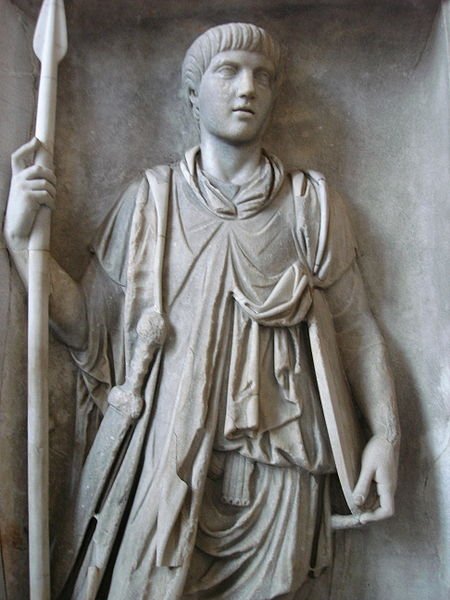
Praetorian Guard: The Powerful and Highly Influential Military Units of Ancient Rome. Image: A Praetorian soldier in the 2nd century A.D.
The first set of the Praetorian Guard under Augustus were required to wear white togas with very little armor, only a basic shield and sword. It was intentional because Rome’s first emperor didn’t want the Roman citizens to feel threatened or intimidated. His ascension to the throne was a sensitive period for Rome, as it marked the transitioning from republic to empire, and Augustus wanted to portray himself as a consul who desired to reinstate the republic.
The Praetorian Guard’s appearance slightly changed under Claudius, who mandated that they be covered in armor. As their pay increased, so did the design and make of their armor. By the end of Emperor Nero’s reign, they had some of the finest and detailed armors of the era.
Of course, the appearance changed as the empire expanded and also as their powers increased. During the reign of Marcus Aurelius (reign: 161 to 180 AD), Rome’s philosopher-king, in 161 AD, the attire of the Praetorian Guard closely resembled that of the emperor’s. Certain historical accounts even mention that some high-ranking officers were allowed to wear purple, which was the color designated for royalty only. During that period, they also wore brightly-colored armors (red) and their capes were made of lion skin. Their armors also included two insignias, which identified them as members of the Praetorian Guard and also the cohort they belonged to. However, they still maintained the white toga underneath their armor.
How did the Praetorian Guard become a powerful body in ancient Rome?
When Augustus formed his Praetorian Guard, they were a band of loyal bodyguards dedicated to protecting and serving the emperor and the royal family. After all, without an emperor, they wouldn’t have a job. Over the years, they were rewarded by subsequent emperors and given more positions, which helped them amass some power. But that all changed in 41 AD when certain members of the Praetorian Guard revolted against Emperor Caligula. But just how did this body grow to become so powerful?
There are several factors to consider concerning how the Praetorian Guard became so influential to the point where they turned against the system that created them not once but numerous times. One of the main reasons was, of course, the task for which they were assigned to do. They had so much power to carry out various activities in the name of the emperor. They were also not required to report to the Senate and they were well-paid than the ordinary soldiers. By the end of Nero’s reign, their pay was three times more than the average soldier’s.

The Praetorian Guard thrived on the power of the emperor; not on the Roman Senate. Perhaps for his own protection, Augustus ensured that It ensured the Guard would not be answerable to anyone except the emperor. Image: Augustus of Prima Porta, 1st century
Again, the Praetorian Guard also had high-ranking officials who assisted the emperor in Rome’s affairs and sometimes acted as second-in-command. Their closeness to that kind of power definitely played a role in their meteoric rise, and it started coming to light during the last few years of Emperor Tiberius’s life.
During Tiberius’ reign (4 AD to 37 AD), one of the prefects Lucius Aelius Sejanus encouraged Tiberius to build a headquarters for the Praetorian Guard in the outskirts of the city. This structure, called Castra Praetoria, allowed them to effectively band together, and it also showed their rising power, as well as the influence they had over emperors. In the last years of Tiberius’s reign, Sejanus more or less acted as pseudo-emperor or the de facto ruler. But his attempts to break into Rome’s high society and aristocracy through marriage fell through, so when Tiberius died, his grand-nephew Caligula succeeded him.
Why did the Praetorian Guard assassinate Caligula?
Caligula might have been a terrible emperor but he was no fool. Recognizing how powerful the Praetorian Guard had gotten, he used his first days as emperor to clear their unpaid bonuses in a bid to secure their loyalty. All was well until the young emperor ridiculed and embarrassed the group.
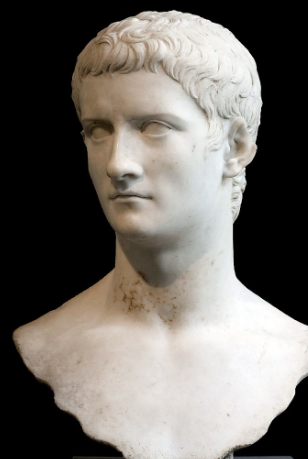
No doubt that the reason why members of the Praetorian Guard assassinated Caligula (in 41 A.D.) was to consolidate their power in Rome. By installing Caligula’s sickly and politically inexperienced uncle, Claudius, the Guard hoped turn Claudius into a puppet. Image: Marble bust of third Roman emperor Caligula dating from his reign
In response, the very powerful military unit conducted a raid, killing Caligula and many members of his family, excluding the emperor’s uncle Claudius who the Praetorian Guard declared emperor. As Claudius had most part of his life being seen as a tactless and least-threatening person, the Guard installed Claudius as a means to further enhance their power.
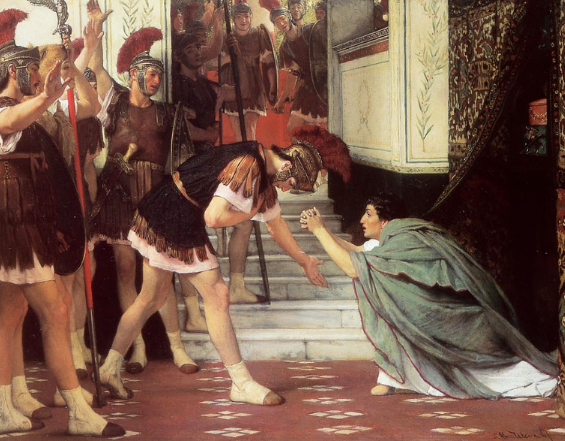
In one account of the story, it is said that Claudius cowered in terror behind a curtain as the Praetorian Guard brutally murdered his nephew, Emperor Caligula. Image: Proclaiming Claudius Emperor, by Dutch painter Lawrence Alma-Tadema, oil on canvas, 1867.
First regicide of the Praetorian Guard
It was the first time that any other body, aside from the Senate, had declared someone emperor. It was probably the first time that the Guard committed regicide, so to speak. However, the historian Tacitus, on the other hand, believes it was the second time rather. According to the historian, the Praetorian Guard had killed Tiberius, Rome’s second emperor. Regardless of whether it was the first or second time, it most certainly wasn’t the last, as they would go on to assassinate a number of emperors. More on this below.
The Praetorian Guard’s Influence in Roman Politics
The love-hate relationship between the Praetorian Guard and the emperors continued well after Caligula’s assassination. In fact, they were so powerful that they were responsible for ending the Julio-Claudian dynasty, which Augustus had founded in 27 B.C.. The dynasty was made up of the first five emperors of Rome: Augustus, Tiberius, Caligula, Claudius, and Nero. The dynasty ended in 68 A.D., when Nero committed suicide after the Senate declared him a public enemy.
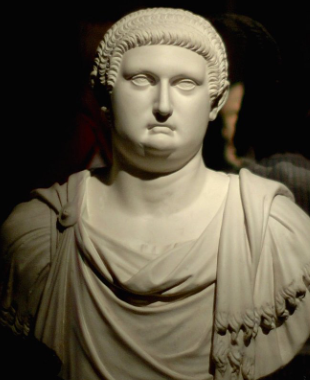
Following the death of Nero in 68 A.D., Galba, governor of Hispania, rose to become emperor with the support of the Praetorian Guard and his legions. Unfortunately for Galba, his choice of Piso Licinianus as successor was rejected by the Praetorian Guard; hence, Galba was assassinated by a general called Otho with the support of the Praetorian Guard. Image: Seventh Roman emperor Otho
They denounced Nero as emperor after his horrific and depraved rule over the empire and installed Emperor Galba, a former governor of Hispania. The denunciation of Nero ended Augustus’s line of rulers, and it also sparked a chaotic period in Roman history known as the “Year of the Four Emperors” (68-79 A.D.), which was a mad grab for the throne. The Praetorian Guard displayed just how powerful it was during that chaotic period which saw four men rule Rome in quick succession. The emperors were: Galba, Otho, Vitellius, and Vespasian. The first three emperors ruled for less than two years, from 68 to 69 A.D, when Vespasian ascended the throne and thereafter established the Flavian dynasty.
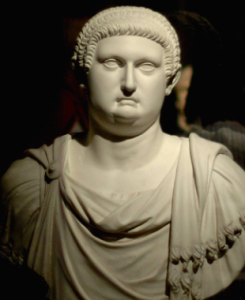
Following the death of Nero in 68 A.D., Galba, governor of Hispania, rose to become emperor with the support of the Praetorian Guard and his legions. Unfortunately for Galba, his choice of Piso Licinianus as successor was rejected by the Praetorian Guard; hence, Galba was assassinated by a general called Otho with the support of the Praetorian Guard. Image: Seventh Roman emperor Otho
Perhaps Galba shouldn’t have gotten too comfortable with his position because they killed him about a year later and installed a new emperor called Otho. Learning from his predecessor’s mistakes, Otho planned to reward the Praetorian Guard in exchange for their loyalty. But both parties were in for a surprise when they lost power to Vitellius during a raid. Vitellius was an army general and when he successfully ousted Otho and the Praetorian Guard, he made sure to form a new one using his soldiers.
Now without the power and prestige they had grown accustomed to, the old members sought help from another army general called Vespasian, and they promised to make him emperor if he could help them remove Vitellius from the throne. For the first time in Roman history, two factions of the Praetorian Guard fought against each other. Vespasian’s victory meant that he was now emperor and he reinstated the old members.

The Praetorian Guard were very influential during the Year of the Four Emperors (68-79 A.D.), a period sometimes known as the first civil war of the Roman Empire. Image (L-R): Galba, Otho, Vitellius, and Vespasian
But there’s a reason why Vespasian is regarded as one of Rome’s best emperors because he chose to remain one step ahead of the Praetorian Guard. He was smart enough to appoint his son Titus (later Emperor Titus) as the new prefect. Although the guards still had power, Rome remained relatively stable during the Flavian and Antonine dynasties. They expanded, served in the army, and won many battles.
Auction of the Roman Empire
The period of calm that came with Vespasian’s ascension to the throne lasted until 192 AD when the Praetorian Guard assassinated Emperor Commodus (161-192). Commodus’ 12-year sole reign (from 180 to 192) was one infamous for bringing an end to the very successful era of the Five Good Roman Emperors, which was the golden age of peace and prosperity (i.e. the Pax Romana). Famous Roman historian Cassius Dio summarizes the end of the Nerva-Antonine dynasty and the ill fortune ushered in by Commodus as Rome’s fall “from a kingdom of gold to one of iron and rust”.

Having jointly ruled Rome with his father Marcus Aurelius from 177 to 180 A.D., Emperor Commodus found himself unprepared to fill the big shoes left behind by Aurelius. In 192, Commodus was killed by his wrestling partner Narcissus in a plot orchestrated by his mistress Marcia and his Praetorian Guard prefects Laetus and Eclectus. Commodus was succeeded by Pertinax, who was in turn assassinated by the Praetorian Guard.
The Guard also killed Commodus’s successor Pertinax because he attempted to limit their powers. The assassination plots of the Guard introduced the tumultuous period known as the Year of the Five Emperors in 193 A.D.
The prefects of the Guard amassed even more power and did the unthinkable: auction the Roman Empire. The highest bidder was a man named Didius Julianus and the Praetorian Guard were swayed by his promise to pay each guard 25,000 sesterces, which was a whole lot of money during that time.
This time around, the Roman Army refused to sit back. They rejected Julianus as the new emperor and a civil war broke out. The army supported a man Septimius Severus and planned to make him emperor. Severus sent word for members of the Praetorian Guard to meet him outside of Rome unarmed. Upon their arrival, he forced them out of their clothes and banished them from the city. With those guards gone, Severus created a new Praetorian Guard to consolidate his reign and dynasty, the Severan dynasty (193-235).
But the new guards were not entirely different from the old. They still influenced who ruled as emperor and still killed emperors they were dissatisfied with, including Elagabalus and Caracalla.
The peak of the Praetorian Guard’s power was when one of their prefects Macrinus became emperor in April 217. It was a short reign (11 April 217 – 8 June 218), but it showed the formidable strength of the guards.
In the case of Elagabulus, the 14-year-old who ascended to throne, it’s said that the young emperor incurred the wrath of the Praetorian Guard and the Roman Senate due to his sexual and religious pervasion. Like his cousin Emperor Caracalla, Elagabulus was killed by the Guard in 222 A.D. Interestingly, it was his own grandmother Julia Maesa, the very woman that helped him rise to the throne, that plotted with the Praetorian Guard to have him killed. Elagabulus was then succeeded by his cousin Severus Alexander.
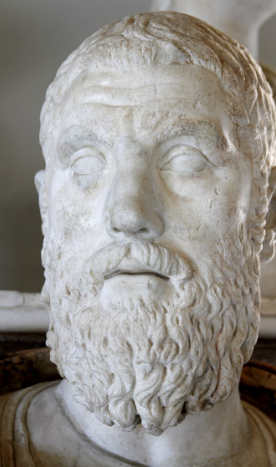
Born into an Equestrian class (i.e. the second of the property-holding classes of Rome), Macrinus served under Emperor Caracalla as a praetorian prefect. He handled the civil affairs of the empire. Macrinus became emperor in April 217 after he and his Praetorian Guard murdered Caracalla. Image: Roman Emperor Macrinus
The assassinations of Caracalla, Macrinus, and Elagabulus by the Praetorian Guard showed just how powerful they were. But that power wouldn’t last forever and it started to wane from 235 AD when the first soldier-emperor Maximinus Thrax was crowned emperor. Under his reign, he moved the capital of the empire away from Italy. The army, on the other hand, started to become more powerful than the Praetorian Guard.
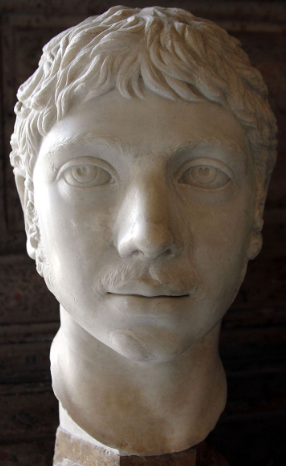
Emperor Elagabalus, a man’s whose four-year reign (218-222) was marred by allegations of religious and sex scandals, was the cousin of Caracalla. He came to the throne with the help of his grandmother Julia Maesa, the sister-in-law of Septimius Severus. His own grandmother and some members of the Praetorian Guard carried out an assassination plot against him. Image: Emperor Elagabalus
The Fall of the Praetorian Guard
The power and influence that the Praetorian Guard had continued to diminish further under the rule of Emperor Diocletian. Unsurprisingly, they were unhappy about their diminishing influence in Roman politics; so, when Diocletian decided to abdicate the throne in 305 AD, they used that opportunity to push for someone who would help restore their power. That person was Maxentius, the son of former Emperor Maximian and the son-in-law of Emperor Galerius. But what they didn’t know at that time was that their support of Emperor Maxentius was the start of their demise.
When was the Praetorian Guard disbanded?
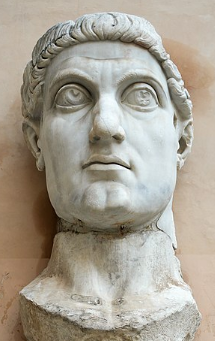
The Praetorian Guard was disbanded by none other than Constantine I, the first Roman ruler to convert to Christianity. Also known as Constantine the Great, the Roman emperor was the son of Emperor Constantius I. Having defeated the likes of Licinius and Maxentius by 324, he Constantine became the sole ruler of the empire.
There was another person who wanted to become emperor and that was Constantine I, also known as Constantine the Great. As expected, another civil war broke out again between Maxentius and Constantine. The Praetorian Guard backed the former. However, Maxentius died in battle, and Constantine became emperor, ruling from AD 306 to 337.
Their leader’s death spelt their loss. About six years after Constantine’s ascension to the throne, he disbanded the Praetorian Guard. But some of them remained and they either became advisors to the emperor or carried out administrative tasks. Who knows what would have become of the Roman Empire had the Maxentius and the Praetorian Guard emerged victorious?
Read More: Top 10 Roman Emperors and their Accomplishments
More Facts about the Praetorian Guard
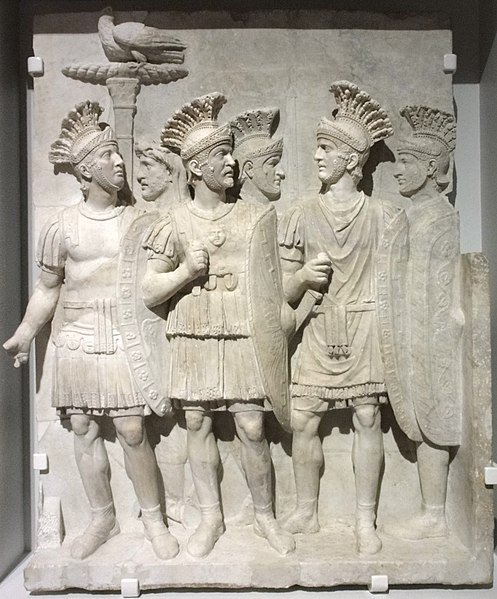
Praetorian Guard
Here are some more facts about the Praetorian Guard:
They fought fires
Ancient Rome was wrought with fires that damaged cities and claimed a lot of lives. The empire already had a group of firefighters called the “Vigiles”, but when the fires were too intense, members of the Praetorian Guard would step in and assist. It was also a way for an emperor to show that he cared for the welfare of citizens by dispatching his guards to help in disasters.
Who were the Roman emperors assassinated by the Praetorian Guard?
In total, the Praetorian Guard killed thirteen emperors during its active years. They were:
-
Caligula (41 AD)
-
Galba (69 AD)
-
Commodus (192 AD)
-
Pertinax (193 AD)
-
Caracalla (217 AD)
-
Elagabalus (222 AD)
-
Balbinus (238 AD)
-
Pupienus (238 AD)
-
Gordian III (244 AD)
-
Philip II (249 AD)
-
Aurelian (275 AD)
-
Numerian (284 AD)
-
Probus (282 AD)
























